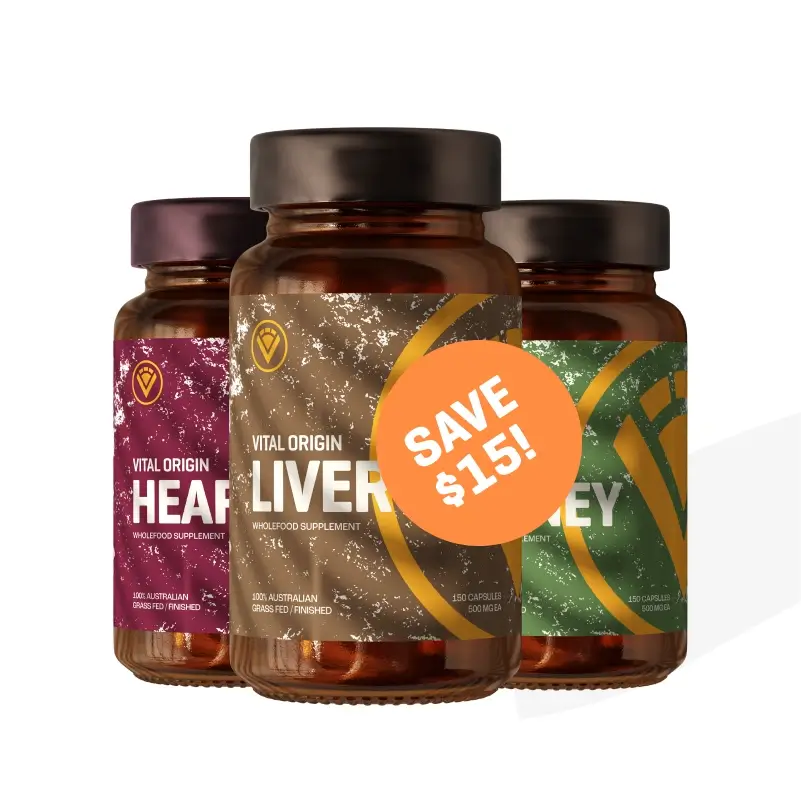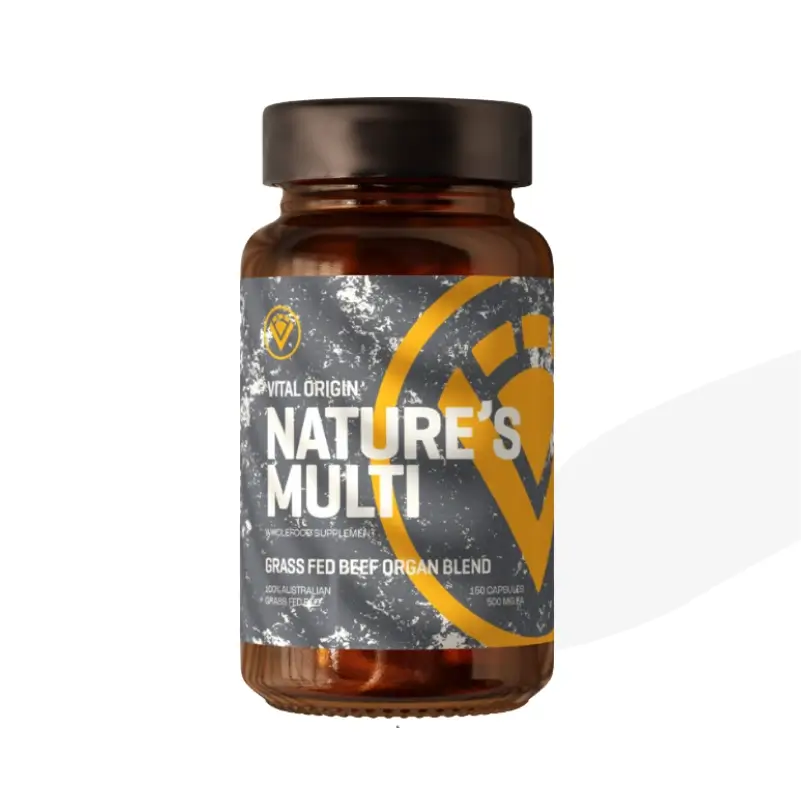

No products in the cart.
Free shipping Australia wide on orders over $80

As we’ve outlined in our Ancestral Health post, for the vast majority of our species history we were hunter gatherers. As hunter gatherers, we consumed a large amount of animals (along with plants too) in order to not only survive but thrive. Animal-based nutrition has been theorised to be a necessary change in our diet during our evolution from other hominids (great apes) – as suggested from the expensive tissue hypothesis mentioned previously, among other well supported theories which we will dive into in future posts. The reason why animal-based nutrition is so important is because of something called Nutrient Density. Nutrient density is the amount of nutrients in a given food per calories provided – so nutrient rich food provides more nutrients (vitamins and minerals) per calorie. This is so important that there is a theory called the Optimal Foraging Strategy [1] which outlines how organisms determine how much energy to expel in order to gain energy and nutrition (we will do a post on this at a later stage as well – hint: it often means animals will seek out nutrient dense animal-based energy rich foods). On the contrary, nutrient poor food such as modern highly processed hyperpalatable foods are extremely nutrient poor – providing less nutrients per calorie. This leads to the overconsumption of calories in an attempt to make up the body’s nutrient needs (particularly protein) – ultimately leading to a condition that many have called being Overfed and Undernourished to entire Westernised populations. To fix this issue, we must look to consume nutrient dense foods, of which animal-based meat and organs are of the highest nutrient density, containing many nutrients which are either insufficient or completely devoid in many plant foods! This is why Vital Origin provides these foods in an easy to consume manner for the modern day – saving you from having to cook and palate organ meats! So let us look at why animal-based meat and organs are so nutrient dense and superior to plant-based foods.
Our bodies are made up of mostly protein, from our connective tissue like muscle, tendon and bone to our hormones and organs. This protein is in constant turnover and needs to be replaced by our diet or we’ll literally die – thus making it an ‘Essential Nutrient’. Protein is made up of amino acids of which there are 9 essential (meaning we must consume them from our diet) and a variety of non-essential and conditionally-essential. We won’t have enough time to dive into all of these here, but just know that we must consume essential amino acids from our diet. When we look at the protein quality of various sources, animal-based is always at the top of the list as it contains all the essential amino acids required – whereas plant-based sources of protein do not contain all essential amino acids and typically have a lower digestion and absorption rating [2]. Protein is in fact so important for the body that there is a theory called the Protein Leverage Hypothesis [3] that suggests an organism will continue to seek out food until it meets its required protein needs! There is a plethora of other data that suggests humans were predominantly meat eaters that we will investigate later such as anthropological evidence, gastrointestinal physiology and nitrogen isotope measures to name a few. Many specific amino acids are particularly important that are not found at all or in meaningful quantities in plant-based foods such as: Anserine, Carnosine, Carnitine, Choline, Glycine and Taurine.
For a long time fat and cholesterol were villainised due to poor, and now outdated and overturned, science. This view has since changed to show that fat and cholesterol are both important nutrients, of which, again, we cannot get into in much detail here. Animal-based foods contain specific fats that are not present or are low in plant-based foods, particularly omega-3 and saturated fats which are required for healthy cells. Omega-3’s are particularly important and most likely many of you would have heard about these before. Omega-3 fats are an important part of our Eicosanoid pathways that regulation inflammation in the body and hence affect overall health. EPA and DHA are what we are typically talking about when we talk about omega-3’s and their benefits. These fats are mostly only available from animal sources (and algae, but this requires specific processing to extract in meaningful quantities). Plants (such as flax and hemp) do contain ALA which the body can convert into EPA and DHA, however, this conversion is extremely poor – only converting around 5% or less of EPA and less 1% to DHA! [4,5] Furthermore, plants tend to be very high in omega-6 polyunsaturated fats which can be more pro-inflammatory when imbalanced against other fats such as omega-3’s and likely plays a role in multiple chronic diseases [6,7] . Cholesterol is also vitally important to our physiology, so much so that most of the cholesterol in your body is actually synthesised endogenously (by your own body) and only ~10-15% is actually absorbed from food [8]. Cholesterol is utilised in every cell in your body, it is used to make your sex hormones and is important for getting fats (and energy) transported around your body. Most dietary guidelines have now removed the dietary limit on consuming cholesterol because the scientific evidence shows that it is not a risk factor for disease (including cardiovascular disease) [9]. Like many of the nutrients listed here, cholesterol can only be found in animal based foods.
B vitamins are important vitamins that support many aspects of our metabolism and also the production of our red blood cells (along with some minerals listed below). Specifically B9 (folate) and B12 play an important role in the production of blood cells and regulating methylation. B12 is yet another nutrient that can only be found in animal based foods and B9 in its active and bioavailable forms can be found in high quantities in organ meats such as liver. Organ meats also tend to be high in bioavailable B2 (riboflavin) also important for many aspects of physiology including methylation. Many B vitamins are deficient in post-Neolithic diets high in grains – hence why many of these foods are ‘fortified’ with artificial nutrients (look up BeriBeri and Pallagra mentioned in our Ancestral Health blog). Then we have the fat-soluble vitamins (meaning they need fat to carry/absorb them) Vit A, Vit D and Vit K2 – all of which again can only be found in animal based foods (some D can be found in mushrooms in low amounts). Vitamin A, like ALA, is found in its inactive forms in plants (beta carotenes) but like ALA this conversion in many people is quite poor [10,11]. Some may have been told Vitamin K is available in plants, and that is technically correct but it is in the form of K1 (phylloquinone) whereas the animal based version is K2 (menaquinones). The K2 form MK7 seems to be the form that has been shown to have the best effects on health and disease improvement [12,13]. And remember, plants tend to be very low in fat overall, which means you will have reduced absorption of any of these fat-soluble vitamins, however little there is present in the first place.
Minerals are another important nutrient for our physiology as they play an important role as cofactors for many processes. I’m sure everyone reading this is familiar with the most common mineral that is found in red meat – iron. Iron is vitally important for transporting oxygen around your body via red blood cells but it is also important in neurotransmitter synthesis and collagen synthesis. Now some plant-based proponents will tell you that iron can be found in plants too; and although this is true, what they don’t tell you is that this is non-heme iron, whereas the type found in animals, and also the type that is significantly more bioavailable for our physiology, is heme-iron (non-heme is only 1-10% absorbed whereas heme is 25-40%) [14]. The richest source of bioavailable heme-iron is organ meats, especially Liver & Spleen. Another key mineral which a lot of people don’t think about is Copper – in fact, some anemias are due to a Copper deficiency affecting the absorption of iron [15]. Copper is another nutrient found in abundance in animal sources such as Organ Meats and oysters. Zinc is yet another key mineral which is found in much higher bioavailable amounts in animal products such as meat, organs and oysters. To compound the importance of animal-based vs plant-based minerals, we also need to consider the affect of “anti-nutrients”. These are compounds found in plants that bind to and/or prevent the absorption of minerals such as phytates, oxalates, tannins and more (a topic we will write about in more detail in the future!).
Hopefully by now I’ve shown convincingly that animal-based nutrition is vastly superior to plant-based nutrition as it provides vitally important nutrients for our human physiology that can not be achieved through plant-based nutrition only (without heavy supplementation of synthetic and artificial nutrients). Out of the animal-based sources of foods, organ meats yet again reign as supreme in nutrient density. This is why Vital Origin provides these foods in a convenient form for the modern day – so you can access sustainably and ethically sourced nutrient dense foods to live your most optimal life!




Post a Comment